Inpatient census 2018: parts one and two
Results of the fourth Mental Health & Learning Disability Inpatient Census and Out of Scotland NHS Placements Census, 2018.
2. Adult patients treated in NHS Scotland facilities (additional detail)
- The bed occupancy rate in NHS Scotland was 84% at the 2018 Census though this ranged from 55 - 100% depending on ward type
- 92% of adult patients received a physical examination on admission or an annual physical health check
- 1,428 patients aged 18+ (42%) were seen by a consultant whose specialty was "General Psychiatry". A further 1,279 (38%) were under "Psychiatry of Old Age".
This section focuses on adult patients, those aged 18+ at the time of the Census. For the 2018 Census, this covers 3,385 patients. This is a 4% decrease on the number of adult patients in 2017 (3,535).
Specialty of Consultant
NHS Boards were asked to record the specialty of every consultant who was responsible for overseeing the treatment of a patient in the Census. A total of 1,428 (42%) patients aged 18+ were seen by a consultant whose speciality was "General Psychiatry", the same proportion as 2017. A further 1,279 (38%) patients aged 18+ came under "Psychiatry of Old Age". Again, this is the same proportion as 2017.
Figure 8: Number of patients, by consultant speciality, 2018 Census, adults aged 18+
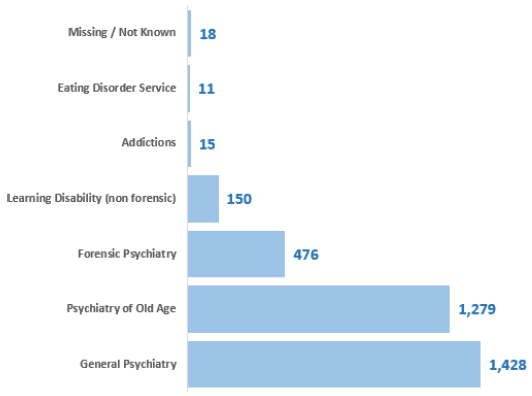
* Some specialities are not included due to small numbers
Length of stay in hospital
There has been a decrease in the "days since admission" from the 2017 to 2018 Census for adults aged 18+. The average (median) length of time was around 4.5 months in 2018, down from around 5 months in previous years.
Table 10: Average (median) length of stay, by Census, adults aged 18+
| Length of Stay | 2014 Census | 2016 Census | 2017 Census | 2018 Census |
|---|---|---|---|---|
| Average (Median) Days | 163 | 150 | 161 | 140 |
| Average (Median) Banded | ~ 5 months | ~ 5 months | ~ 5 months | ~ 4.5 months |
There was a wide spread in the length of time a patient aged 18+ has spent in hospital. One in four patients have spent between 1 and 5 years in hospital, while around one in ten have spent over 5 years. One in twenty patients have spent less than 72 hours in hospital.
Figure 9: Days since admission, banded, 2018 Census, adults aged 18+
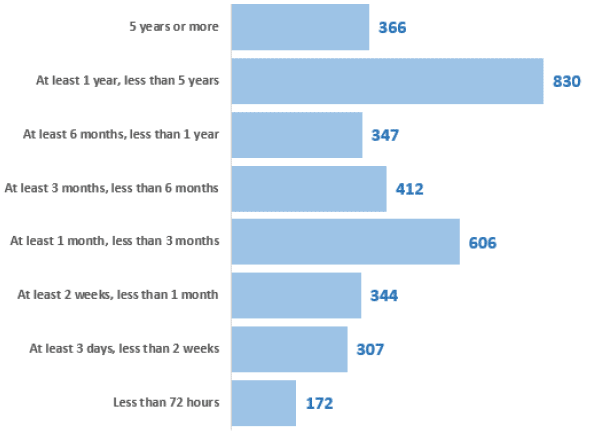
* 1 patient with error for date of admission
Status
Patients who have been detained under the provisions of the Mental Health (Care and Treatment) (Scotland) Act of 2003 are defined as having "Formal" status. "Informal" refers to voluntary Mental Health Admissions.
Of those adult patients in the 2018 Census, 1,611 (48%) were admitted with "Formal" status. This increased to 1,653 (49%) of adult patients at the time of the Census.
Other Legislation
NHS Boards returned data on a range of legislation for which patients were subject to at the 2018 Census. A total of 980 patients aged 18+ were subject to the Adults with incapacity (Scotland) Act 2000. A further 878 patients (35% of those applicable) were subject to the Mental Health Act (Compulsory Treatment Order).
Figure 10: Number of patients, subject to legislation, 2018 Census, adults aged 18+
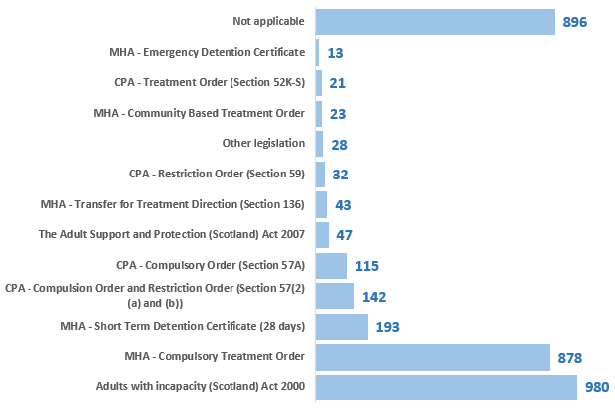
* MHA - Mental Health Act, CPA - Criminal Procedure Act
** Patients can be subject to more than one piece of legislation
*** Some data has been excluded for disclosure control
Health and Wellbeing
Mental health morbidities
NHS Boards returned diagnosis codes (ICD 10) for any mental health condition for which patients in the 2018 Census had a diagnosis. A total of 2,534 (78%) patients aged 18+ with a known diagnosis (unknown for 124 patients) had only one mental health condition recorded, while 727 (22%) had a diagnosis for 2 or more condition.
Figure 11: Number of patients, by number of mental health conditions), 2018 Census, adults aged 18+
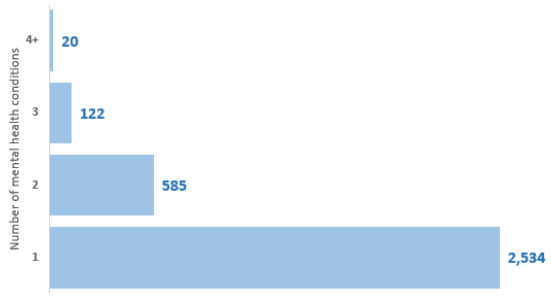
* No diagnosis yet or unknown diagnosis for 124 patients
Figure 12 presents the most commonly diagnosed mental health morbidities, as at the 2018 Census, for adults aged 18+. These include primary as well as secondary diagnoses. In addition, separate questions on autistic spectrum disorder and personality disorders allowed for cross-comparison with diagnosis codes to pick up any patients missing relevant codes.
Schizophrenia was the most common diagnosis with 927 patients (27% of all adult patients) having this diagnosis. This was followed by dementia, where 923 patients (27% of all adult patients) had this diagnosis. Patients with a personality disorder accounted for 10% of the 2018 Census. Patients may have more than one diagnosis.
Figure 12: Number of patients, by mental health diagnosis, 2018 Census, adults aged 18+
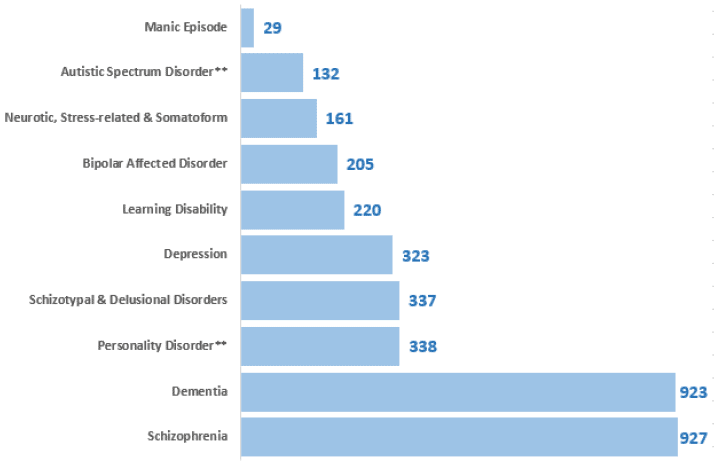
* Mental health diagnoses are based on ICD 10 codes. Primary and secondary diagnoses included.
** Personality disorders and autistic spectrum disorder counts also rely on respective questions on these disorders.
*** Patients may have more than one diagnosis.
**** Some diagnoses may not be included due to small numbers.
Learning Disabilities and Autism
Of the 3,385 patients aged 18+ at the 2018 Census, 278 (8%) patients had a diagnosis for either a learning disability or autism, with 220 (6%) patients having a diagnosis for a learning disability and 132 (4%) patients having a diagnosis for autism (74 patients had a diagnosis for both).
Physical health co-morbidities
The Mental Health Strategy 2017 - 2027 emphasises the importance of considering physical health along with mental health and how the outcomes of both are linked. A key outcome from the 2014 Census was the need to improve the recording of both mental and physical health morbidities. Mental health and learning disability services in NHS Boards are working towards routinely recording physical health conditions under the International Classification of Diseases. The 2016 Census included a suite of Yes/No physical health questions and these were retained for the 2018 Census. Physical health information was returned for all except one adult patient.
List of yes/no physical health morbidities questions in the Census:
- Hypertension,
- Dyslipidaemia,
- Coronary heart Disease,
- Epilepsy,
- Chronic Kidney Disease,
- Thyroid Disease,
- Cancer,
- Alcohol Acquired Brain Injury,
- Diabetes,
- Chronic Obstructive Pulmonary Disease,
- Chronic Pain,
- Sensory Impairment,
- Liver Disease,
- Acquired Brain Injury,
- Stroke / Transient Ischaemic Attack,
- Parkinson
A total of 2,046 patients aged 18+ (60%) had at least one physical health co-morbidity based on the suite of Yes/No physical health questions at the 2018 Census. This is higher than the 58% figure reported in 2017 and 53% in 2016.
Figure 13: Number of patients, by number of physical conditions, 2018 Census, adults aged 18+
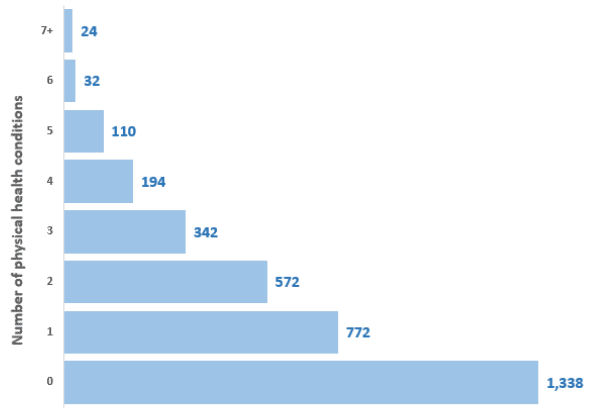
* 1 patient had no physical health information returned
Figure 14 shows a breakdown of the number of patients aged 18+ for each physical condition as asked in the suite of Yes/No questions. Of all the adult patients in the 2018 Census, 17% had hypertension, with 81% of these patients being on anti-hypertensive medicines. The same proportion of patients had a sensory impairment (17%), while 12% of patients had diabetes and 12% had a chronic pain condition.
Figure 14: Number of patients, by physical condition, 2018 Census, adults aged 18+
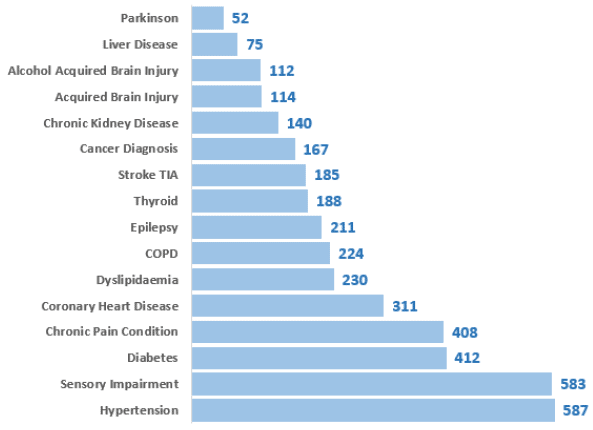
* Patients can have more than one physical condition
Physical Health Check
The 2017 Census included, for the first time, questions related to physical health checks. These follow on from actions on mental health set out by the Chief Medical Officer (http://www.sehd.scot.nhs.uk/cmo/CMO(2015)19.PDF). There were two questions;
- For patients admitted to a mental health bed within the last year: Did the patient receive a general physical examination by a qualified clinician within a day of admission?
- For patients admitted to a mental health bed over one year ago: Has the patient had an annual (physical) check within the last year? An annual health check should be both a physical assessment and delivery of health promotion activity.
Of the 2,184 patients aged 18+ for whom data on a general physical examination was returned, 2,026 (93%) received a general physical examination within a day of admission. This is higher than the 89% reported in 2017. A further 45 (2%) of patients were offered an examination but declined.
Figure 15: Number of patients, general physical examination, 2018 Census, adults aged 18+
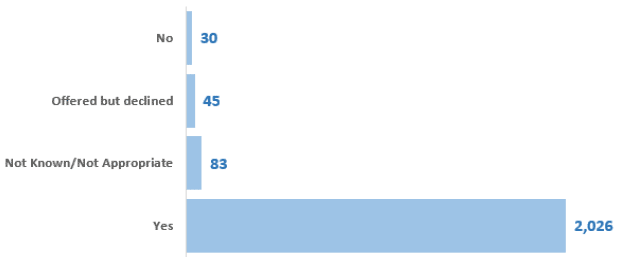
Of the 1,181 patients aged 18+ for whom data on an annual physical examination was returned, 1,075 (91%) received a health check within the last year. This is higher than the 82% reported in 2017. A further 35 (3%) of patients were offered but declined.
Figure 16: Number of patients, annual physical health check, 2018 Census, adults aged 18+
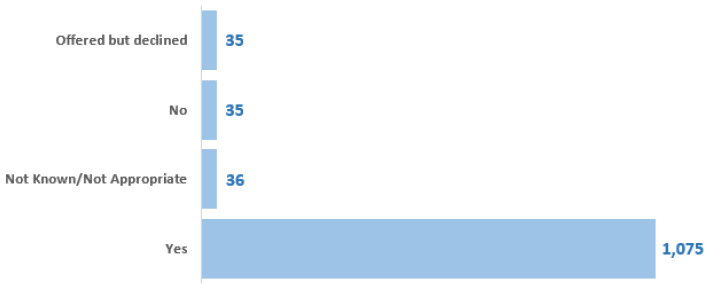
Overall in the 2018 Census, a total of 3,121 (92%) of adult patients received some form of physical health check, a percentage point increase of 5% on 2017. A further 80 (2%) were offered but declined a physical health check.
Lifestyle factors
BMI (Body Mass Index)
BMI (Body Mass Index) was calculated for patients whom height and weight information was returned. Please note the following statistics exclude patients in eating disorder wards.
A total of 158 (5%) patients were excluded because height and weight information was either not provided or were extreme outliers. Of the rest, 1,176 (35%) patients had a normal BMI, while 56% were overweight or obese.
Figure 17: Number of patients, by BMI Index, 2018 Census, adults aged 18+
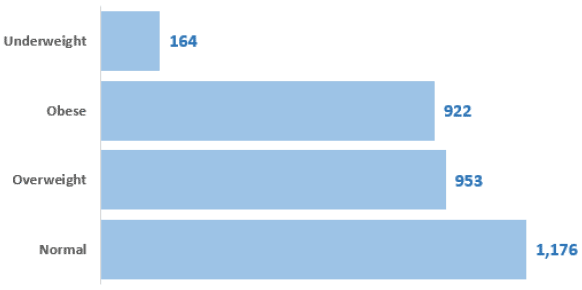
Smoking, alcohol and drug misuse
The 2018 Census included a number of questions around alcohol and other substance misuse. It is known that not all patients with alcohol dependence or substance abuse will have a formal (ICD 10) diagnosis. This section contains analysis of patients with alcohol dependence and/or substance misuse based on responses for a combination of questions. A minor methodological change was made in 2017 (see Section 7 for further detail).
A total of 1,092 (32%) patients aged 18+ smoked tobacco in the 12 weeks prior to the Census date. In 2017 this was 33% and in 2016, 35%, showing a gradual decrease over time.
In the 2018 Census, 642 (19%) of patients aged 18+ had a history of alcohol dependence in the four weeks prior to admission, of which 130 (20%) had an alcohol related diagnosis based on ICD 10 codes. In 2016 and 2017, the proportion of patients with a history of alcohol dependence in the four weeks prior to admission was also 19%.
A total of 604 (18%) of patients aged 18+ had abused substances (excluding alcohol) in the four weeks prior to admission. Of these, 106 (18%) had a diagnosis of drug misuse based on ICD 10 codes. The proportion of adult patients who had abused substances (excluding alcohol) in the four weeks prior to admission was similar in 2016 and 2017.
Figure 18: Number of patients, smoking, drugs and alcohol, 2018 Census, adults aged 18+
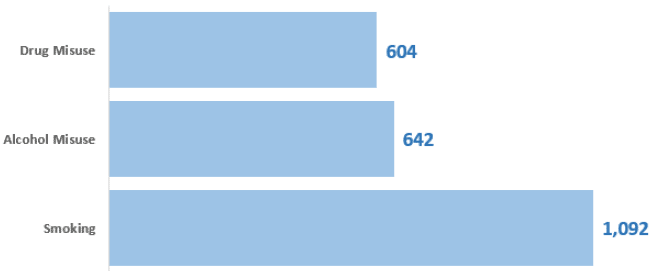
Substances used prior to admission
NHS Boards returned data on substances used by patients in the four weeks prior to admission. For patients with a record of substance abuse (excluding alcohol) in the four weeks prior to admission (604 patients), cannabis was the most prevalent with 340 (56%) recorded as having used it. Amphetamine was the second most prevalent, with 98 (16%) of patients recorded as having used it, followed by heroin, 88 (15%).
Figure 19: Number of patients, substances used 4 weeks prior to admission, 2018 Census, adults aged 18+
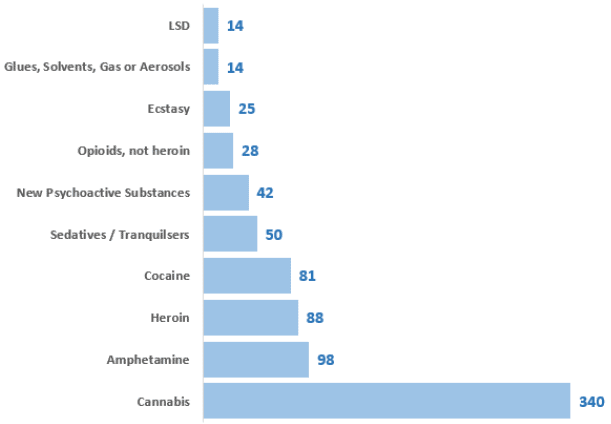
* Patients can be in more than one category
** Does not include all substances
Of the 604 patients with a record of substance abuse (excluding alcohol) in the four weeks prior to admission, 334 (55%) patients used only one substance, while 164 (27%) used two or more. Detailed information on substances used was not returned for 106 (18%) patients.
Table 11: Number of patients, by number of substances used and Census, adults aged 18+
| Number of substances used per patient in 4 weeks prior to admission | 2016 Census | 2017 Census | 2018 Census | |||
|---|---|---|---|---|---|---|
| One | 291 | 57% | 316 | 59% | 334 | 55% |
| Two | 79 | 15% | 70 | 13% | 92 | 15% |
| Three | 41 | 8% | 34 | 6% | 34 | 6% |
| Four | 19 | 4% | 16 | 3% | 22 | 4% |
| Five or more | 13 | 3% | 24 | 4% | 16 | 3% |
| Not known | 72 | 14% | 79 | 15% | 106 | 18% |
Of the patients with recorded substance abuse in 4 weeks prior to admission, 361 (60%) used smoke or nasal as the main route of substance abuse, 181 (30%) oral and 51 (8%) injected (patients can use more than one route).
Self-harm
NHS Boards returned information on whether patients self-harmed in the week prior to admission. In the 2018 Census, this was known for 3,113 (92%) of adult patients. Of these, 331 (11%) self-harmed in the week prior to admission. A total of 221 (67%) of these patients self-harmed by non-accidental injury.
Figure 20: Number of patients, by method of self-harm, 2018 Census, adults aged 18+
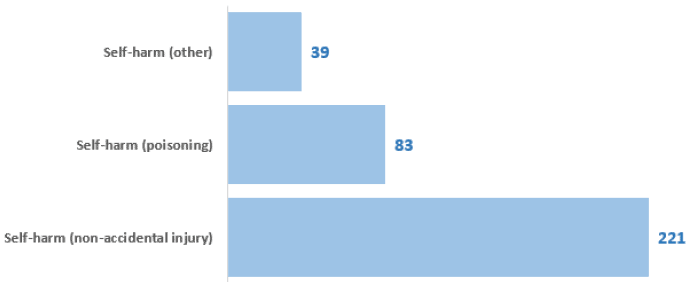
* Patients can be in multiple categories
There were no gender differences for those adults self-harming in the week prior to admission, 51% male V 49% female. Almost half (48%) of those self-harming were aged between 18-39, while 13% were aged 65 and over.
Suicidal ideation
NHS Boards returned information on whether patients were expressing suicidal ideation on admission. This information was returned for 3,229 (95%) of patients. Of these, 447 (14%) expressed suicidal ideation on admission.
There were slightly more females expressing suicidal ideation on admission (56%) compared to males, while 39% were aged between 18-39, and 39% aged between 40-64.
Contact
Email: Guy McGivern
There is a problem
Thanks for your feedback